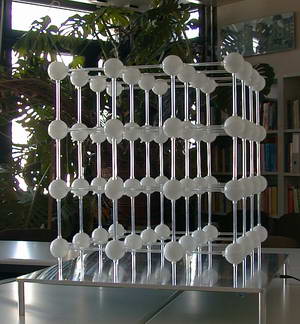 |
 |
||
|
|
|
||
|
|
Overview of the BioCube
21st century computing will be performed on machines constructed by assembling atoms or molecules with nanotechnology tools at the nanometer scale. The BioCube, developed at the Ecole Polytechnique Fédérale de Lausanne (EPFL), is a prototype that embodies the operating principles of such a machine, blown up a billion times. It is organized as a cube of 4x4x4=64 nodes, where each node consists of a processor implemented by a programmable logic circuit (FPGA = Field-Programmable Gate Array). The complete BioCube foreshadows a three-dimensional nano-computer, where each node will be realized by a group of atoms, a molecule. 
Reduced to the microscopic dimensions of an array of molecules, the nano-computer will feature some of the properties of living organisms, such as self-repair. Extremely robust, it will be exploited wherever reliability is crucial. In space, it will become an indispensable tool for automatic probes; on Earth, it will allow the development of systems capable of operating even if their atomic-scale components become momentarily or permanently faulty. The BioCube, in its current form, is a cube of 64 transparent spheres. Each sphere contains an electronic circuit and possesses an internal state computed as a function of the states of the six cardinal neighbors to which the sphere is connected. This completely homogeneous structure allows the direct implementation of three-dimensional cellular automata: a 3D version of the "Game of Life" will be among the first applications to be developed on the BioCube, together with several variants of self-replicating cubes. These last will open the way to the realization of three-dimensional artificial organisms whose structure, inspired by biological systems, will allow them to grow through cellular division and differentiation, to self-repair, and to self-replicate. Ressources
|



